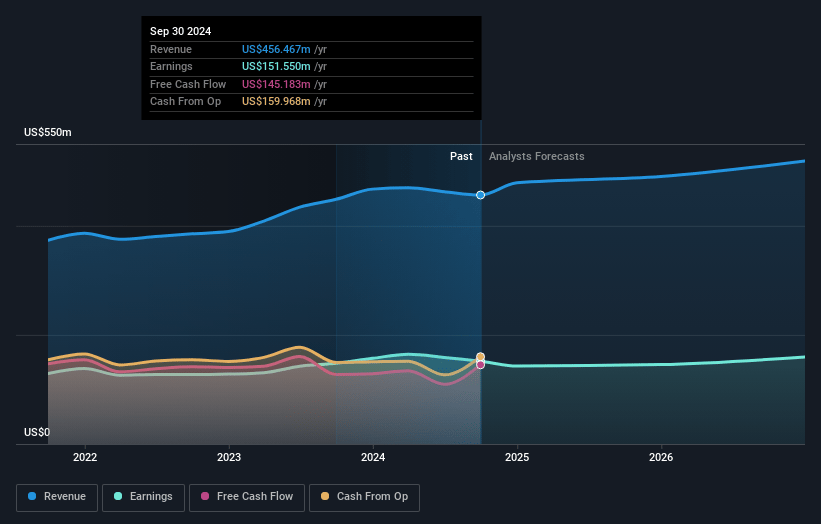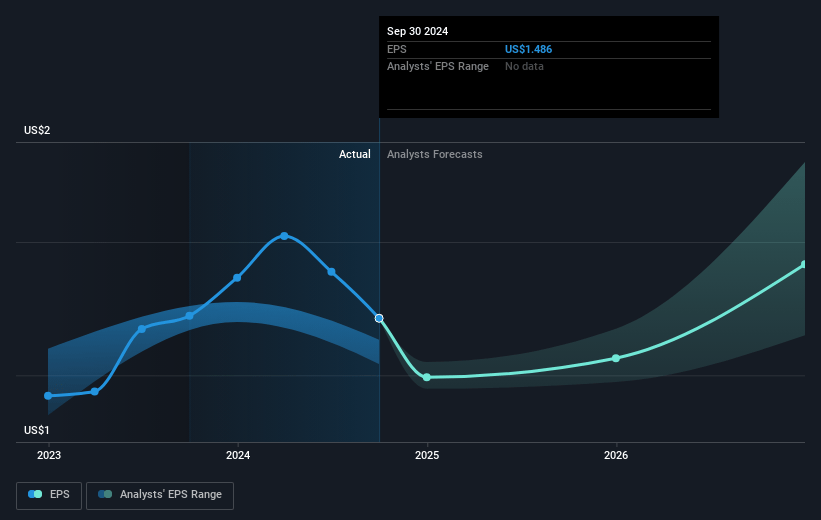Narratives are currently in beta
Key Takeaways
- Focus on SBA lending and strategic recruitment are expected to drive revenue and improve net interest income.
- Enhanced customer satisfaction and optimized balance sheet management could boost revenue and improve net margins.
- The Centric acquisition and rising noninterest expenses challenge profitability, while declining net interest margins and regulatory impacts threaten credit quality and earnings growth.
Catalysts
About First Commonwealth Financial- A financial holding company, provides various consumer and commercial banking services in the United States.
- First Commonwealth's focus on strengthening its SBA lending, evidenced by recognition as a top lender in Western Pennsylvania, is expected to drive future revenue growth and expand their fee income from SBA loan sales.
- The recruitment of new commercial banking talent and a focus on growth in attractive markets like central and Eastern Pennsylvania should help drive loan growth and improve net interest income in the coming years.
- Improved customer satisfaction and Net Promoter Scores, which have reached five-year highs, suggest potential for increased client retention and business expansion, potentially boosting overall revenue and relationship banking fees.
- The removal of excess cash on the balance sheet by paying down borrowings should improve the net interest margin, enhancing earnings as the bank optimizes its balance sheet management in a changing rate environment.
- Continued progress in managing and improving the credit performance of the Centric loan portfolio is expected to lower future credit costs, improving net margins as they achieve convergence with stronger overall credit metrics.
First Commonwealth Financial Future Earnings and Revenue Growth
Assumptions
How have these above catalysts been quantified?- Analysts are assuming First Commonwealth Financial's revenue will grow by 5.6% annually over the next 3 years.
- Analysts assume that profit margins will shrink from 33.2% today to 29.9% in 3 years time.
- Analysts expect earnings to reach $160.5 million (and earnings per share of $1.58) by about November 2027, up from $151.5 million today. However, there is some disagreement amongst the analysts with the more bullish ones expecting earnings as high as $176.6 million.
- In order for the above numbers to justify the analysts price target, the company would need to trade at a PE ratio of 14.0x on those 2027 earnings, up from 12.6x today. This future PE is greater than the current PE for the US Banks industry at 12.9x.
- Analysts expect the number of shares outstanding to grow by 0.09% per year for the next 3 years.
- To value all of this in today's terms, we will use a discount rate of 5.92%, as per the Simply Wall St company report.
First Commonwealth Financial Future Earnings Per Share Growth
Risks
What could happen that would invalidate this narrative?- The Centric acquisition continues to adversely affect First Commonwealth Financial's credit performance, accounting for a disproportionate share of commercial and total charge-offs, which could negatively impact net earnings and credit quality metrics.
- Elevated noninterest expenses, partly due to onetime items, could strain profitability and pressure net margins, especially if cost management fails to improve in the following quarters.
- The decline in net interest margin, influenced by the anticipated rate cuts and excess cash, suggests pressure on interest income, potentially affecting overall earnings growth.
- The increasing provision expense on legacy loans and asset quality challenges, such as specific reserves on large nonperforming credits, could exacerbate credit risk and erode net earnings.
- Regulatory impacts, such as the Durbin amendment, have substantially reduced interchange income, posing risks to noninterest revenue streams and overall profitability.
Valuation
How have all the factors above been brought together to estimate a fair value?- The analysts have a consensus price target of $18.67 for First Commonwealth Financial based on their expectations of its future earnings growth, profit margins and other risk factors. However, there is a degree of disagreement amongst analysts, with the most bullish reporting a price target of $21.0, and the most bearish reporting a price target of just $16.0.
- In order for you to agree with the analyst's consensus, you'd need to believe that by 2027, revenues will be $537.0 million, earnings will come to $160.5 million, and it would be trading on a PE ratio of 14.0x, assuming you use a discount rate of 5.9%.
- Given the current share price of $18.84, the analyst's price target of $18.67 is 0.9% lower. The relatively low difference between the current share price and the analyst consensus price target indicates that they believe on average, the company is fairly priced.
- We always encourage you to reach your own conclusions though. So sense check these analyst numbers against your own assumptions and expectations based on your understanding of the business and what you believe is probable.
How well do narratives help inform your perspective?
Disclaimer
Warren A.I. is a tool utilizing a Large Language Model (LLM) that ingests data on consensus price targets, forecasted revenue and earnings figures, as well as the transcripts of earnings calls to produce qualitative analysis. The narratives produced by Warren A.I. are general in nature and are based solely on analyst data and publicly-available material published by the respective companies. These scenarios are not indicative of the company's future performance and are exploratory in nature. Simply Wall St has no position in the company(s) mentioned. The price targets and estimates used are consensus data, and do not constitute a recommendation to buy or sell any stock, and they do not take account of your objectives, or your financial situation. Note that Warren A.I.'s analysis may not factor in the latest price-sensitive company announcements or qualitative material.
Read more narratives
There are no other narratives for this company.
View all narratives



